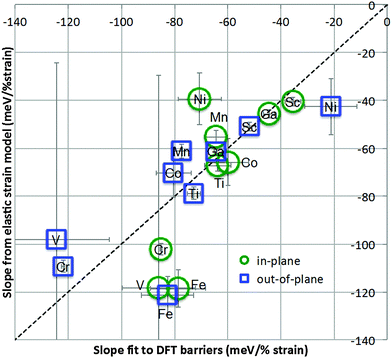 Open Access Article
Open Access ArticleCreative Commons Attribution 3.0 Unported Licence
Correction: Strain effects on oxygen migration in perovskites
Tam
Mayeshiba
a and
Dane
Morgan
*b
aMaterials Science Program, University of Wisconsin-Madison, Madison, WI 53706, USA
bDepartment of Materials Science and Engineering, University of Wisconsin-Madison, Madison, WI 53706, USA. E-mail: ddmorgan@wisc.edu
First published on 17th February 2016
Abstract
Correction for ‘Strain effects on oxygen migration in perovskites’ by Tam Mayeshiba et al., Phys. Chem. Chem. Phys., 2015, 17, 2715–2721.
An error in one of our equation of state analysis codes mistaking Python 2.7 integer division for float division produced delta in migration energy per percent strain (DMEPS) values for the elastic strain model that were erroneously small in magnitude. Correcting this error affects all of the discussion and data associated with the elastic strain model, and improves the comparison of the elastic strain model’s DMEPS values with the DMEPS values fit to ab initio migration barriers.
The essential plot is corrected below as Fig. 5R, which shows that the DMEPS predicted by the elastic strain model now follow the same trend as our ab initio DMEPS. In contrast to the claim made in the original paper, the strain model DMEPS no longer underrepresent the ab initio DMEPS.
The corrected strain model DMEPS differ from the ab initio DMEPS by an average of 16 ± 13 meV/% strain (where the uncertainty represents one standard deviation of the error from the mean) with a maximum error of 40 meV/% strain and a root-mean-squared error of 20 meV/% strain. These values are improved from the average of 22 ± 16 meV/% strain, maximum error of 56 meV/% strain, and root-mean-squared error of 27 meV/% strain in the original paper.
The elastic strain model therefore qualitatively describes the response of oxygen migration barriers in perovskites with respect to biaxial strain, including the correct overall trend. However, the model has significant errors for a number of specific systems, and the discussion of those systems from the original paper remains valid.
The Royal Society of Chemistry apologises for these errors and any consequent inconvenience to authors and readers.
| This journal is © the Owner Societies 2016 |

